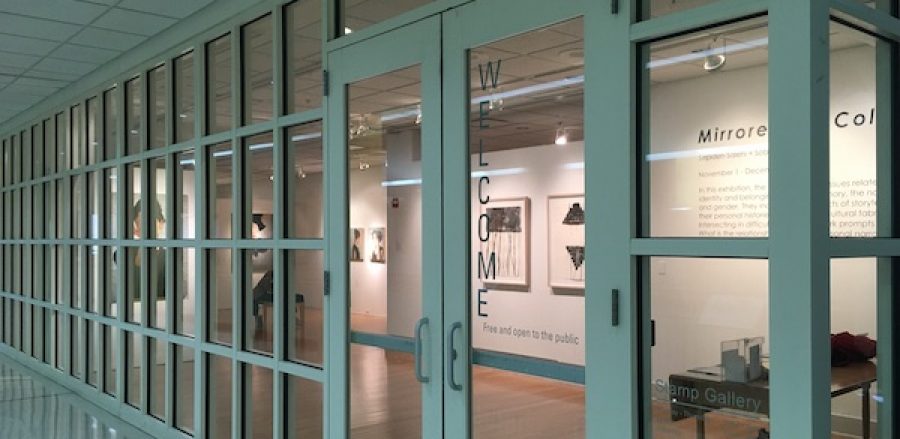Binary Socks
Posted: February 27, 2023 Filed under: Current Exhibition | Tags: baltimore, Elliot Doughtie, installation, Isabella Chilcoat, sculpture, Socks, studio, UNFOLD Leave a commentUNFOLD from January 30 to April 1, 2023 at The Stamp Gallery | University of Maryland, College Park | Written by Isabella Chilcoat
I first encountered artist Elliot Doughtie’s work last November of 2022 during my Contemporary Art Purchasing Program cohort’s visit to his studio in Baltimore City. We arrived early in the morning (in a university van) for a full day of gallery and studio visits, and Doughtie was first on the docket. He greeted us outside of Area 405, the historic Baltimore warehouse that houses a number of working artists’ studios and emits the familiar musk that so many historic properties possess after sheltering decades of dust from the bustle of busy humans. Surrounded by the energies of creatives past and present, my team members and I were eager to explore the brick-walled universe of expression and curiosity.
Enter Doughtie’s studio. The floors are gray wooden boards met by drywall panels in between exposed brick. The drywall patches are covered in graph paper sketches of concepts, ideas, and the two sock drawings that now hang in the Stamp Gallery as part of the group exhibition UNFOLD. There are two rooms, one main studio space testing the display of sculpture and installations followed by a narrow hallway to a smaller workspace. Throughout the studio are socks. Not real socks, but heavy, brittle sculptures and mock-ups capturing the exact texture of fabric created through an all but easy process of pouring plaster into molds cast from bulk-buys of generic gym socks. Inside the smaller workspace room resides a circular saw, molds, and other scattered tools. Imagine a public education shop class room, then make it half the size, then fill it with various sizes of plaster fragments, pipe, and little empty replica bottles of Testosterone.
Just as the plaster fragments spread across the floor of the studio, Doughtie’s finished sock sculptures rest on the wooden floors in the Gallery. What most visitors do not know is that they weigh around eighty pounds, can shatter, and are not, in fact, real socks. The closest element they bear to the fabric socks used to create their molds is the red striped detail above the ankle. The red dye in the original sock transferred to the absorbent plaster during casting. An expert dupe, these conceptual socks would likely crush under the weight of a foot, which is what makes them so fantastic as works of art! They subvert any ordinary conception people hold about socks; Doughtie’s are not the resilient little things we banish to hampers, closet floors, or washing machines every evening. Instead the art socks on the floor are metaphors for the crushing weight of our society’s masculine stereotypes.
Further exemplified in the diptych drawings of socks on the gallery’s first wall, the illustrations oppose each other by contrasting a picture of many socks crowded together with a picture of just one sock in isolation. Despite what initially feels like a playful subject, the illustration with only one sock is chillingly lonely. The single sock floats at the bottom of its page as if staring at the crowd of intertwining socks separated by two frames. Socks come in pairs, like binaries, and can only fulfill their prescribed purpose if they are together. The idea of losing one sock from a pair likely raises neck hairs for anyone who has scoured a house in search of that elusive piece of polyester-blend hosiery. It also highlights the devastating pressures to conform to a stereotype or standardized identity for belonging. Focusing on a single, separated sock from the cluster really spotlights the metaphor for stereotypical masculinity and exposes its weaknesses beyond the safety of sameness. These all-but-essential unspoken codes dictating binary gender expression inflict droves of problems, and Doughtie’s single sock captures some of the feelings associated with rejecting the standard.
The lonely sock suggests dual ideas that the pressure of assimilation is crushing, and, ironically, so is the isolation. I am grateful for the physical space in between the picture frames, however, because I needed it to remind me about the gray area. Our world is frequently so suffocatingly black and white, but life is much more complex and colorful beyond the binary.
Elliot Doughtie’s work is included in UNFOLD at The Stamp Gallery of the University of Maryland, College Park, from January 30 – April 1, 2023.
For more information on Elliot Doughtie, visit https://elliotdoughtie.com/ .
For more information on Unfold and related events, visit https://stamp.umd.edu/centers/stamp_gallery
